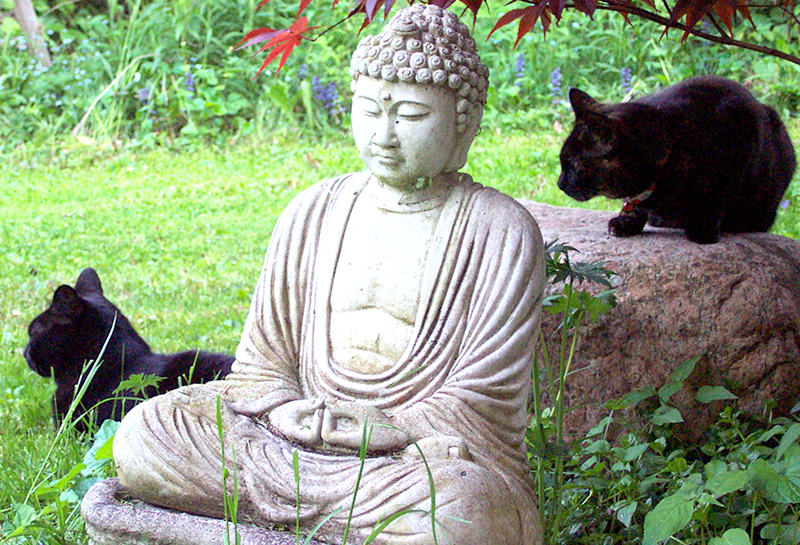How do you begin a class with mindfulness or practice it yourself? Once you and your students have all entered the classroom and greeted each other, invite your students to join you in practice. Or if you’re by yourself, commit yourself for a certain length of time, and even set an alarm, so you can focus on the practice, not on keeping time:
Let’s begin class today with a short mindfulness practice or just enjoying the fact that we’re here together. The focus will be on the breath and calming mind and body. Or if you’d prefer, simply sit quietly or take out a journal and do a free write.
Push away from your desk. Sit up straight but not rigid, near the front end of your seat, so you don’t get tempted to slump. Or, if you’d like, sit cross-legged on the floor. Then turn your attention inwards. Exhale through your nose, and then notice how you inhale. You do it naturally, spontaneously, don’t you? Just notice the sensations of breathing.
Mindfulness is both a practice and an open, curious, moment to moment awareness. When leading a practice use a calm tone of voice. Giving choices to students is important, so they feel empowered and that their own preferences are important to you. When possible, give two or three choices. Some students won’t want to close their eyes, so give them a few different alternatives. Never force anything. Speak clearly, while monitoring your own feelings and thoughts as they arise so you can be in tune with the students.
Close your eyes partly or fully. Or if you want to leave them open, pick a spot on the floor about three feet in front of you, and let your eyes rest on that spot. Notice what it feels like to take in a breath. You might notice your body expanding slightly with the breath. Simply notice the sensations as you inhale. As you exhale, notice the sense of exhaling. Notice how your body can let go, settle down, relax a bit. It’s like a momentary holiday.
Never lead something that you haven’t practiced many times. Before leading any exercise, imagine doing it with your particular students, so you note who might have difficulty with it and what they might be feeling. Start with just this much, just two minutes. You, and the students, will soon want more. Do the rest of this practice when you’re ready.
Once your mind and body quiet, you might notice awareness of what is going on inside yourself on a new level. You can become aware of awareness itself. You might begin to hear thoughts and beliefs or feel sensations that were previously automatic. You might feel pressure to immediately react to these thoughts and feelings and to take them as important. Instead, let whatever arises be the object of awareness. Even the sensation of pressure. By simply noticing, instead of a thought or sensation dominating your mind, your mind becomes simply noticing, becomes awareness itself.
Notice how long or short, deep or shallow your breaths are. (Pause.) Notice if any place in your body is tense. Go to that area with your awareness and just notice it. Notice how the area expands as you breathe in. Then relaxes, settles down as you breathe out. There is a natural rhythm here. Then go to another part of your body. Notice how you breathe in from that area. Notice your body expand as you breathe in and lets go as you breathe out.
If you feel tension, you might immediately react with an impulse to run away from the feelings. Or if you feel pleasant sensations, you might feel an impulse to grasp onto them and not let go. You might not want these unpleasant feelings and thoughts to be there; you might not want the pleasant ones to end. Or sometimes you might feel confused or not want to do anything. Your awareness might switch from the initial feeling to your response to the feeling. The two are different.
If you find yourself drifting away, just notice it and gently return your awareness to the breath.
What do we do when we realize we lost our focus or got caught by a train of thoughts or responses to sensations? Maybe we spent a few breaths engaged in a memory or following the sound of someone laughing in the hall. We all lose focus at times. If at the moment of realization we get down on ourselves, we lose focus again. If we get angry at the people disturbing our practice with laughter, or angry with ourselves, we lose focus. If we are kind, gentle, and committed to returning attention to awareness, we regain focus. We feel good.
The initial sensations or feelings of an emotion have a message for us. But we lose the message contained in the initial feeling when we switch attention from it to our emotional response. So if possible, return to the initial feeling, before memory or language arise.
We are learning how to respond to life itself, to be kind, gentle and aware. We are helping ourselves and our students learn how to return attention over and over again to the object of attention.
If you notice a student is falling asleep, just smile and take that in. If someone is having difficulty, their breathing rate is increasing or they seem to be getting lost in a painful memory, offer other points of attention to the class⎼ suggest students could focus on the feeling of their feet on the floor or their hands on their lap. Or if there is a gentle breeze outside or birds calling, you could offer that as a point of focus. Never force or pressure participation. You need to be aware of your own responses when you notice your students not participating and take it as a message to return your own focus to the breath.
If any thoughts or images arise, just notice them with your inhalation, and then settle down, relax, let go as you exhale.
Part of why we react to sensations as we do is because of our past experiences or the ways we were taught to respond. Many of us carry painful memories or trauma. We might have developed automatic ways to respond situations that undermine our sense of autonomy. We might fear awareness or simply were not taught how to be so aware. We might have become unsure of our ability to handle a situation. We might have beliefs or theories about reality that have not been carefully questioned.
For example, if we feel a pain in our chest and imagine it is a heart attack, the level of pain goes up. If we realize it is acid reflux, our fear decreases considerably. Mindfulness is not psychological analysis. We are just breaking down automatic responses by becoming aware of the simplest elements of our experience. What is the feeling of our feet on the floor? Taking a breath? Keep it simple. Yet, nothing could be more profound.
Just sit for a minute with the calm and quiet of having nothing to do but breathe in and breathe out or listen to bird calls outside the window.
And once we develop the ability to just sit with whatever arises for us, we have patience with ourselves and with others. We are kinder to ourselves and we allow ourselves to think more deeply. If something arises that we feel uncomfortable with in the situation, we know we have choices about how to respond. We can go back to putting our attention on a simpler sensation or switch to another practice. Or we can persist in completing even what feels difficult.
Or if we have to face a difficult task and we feel a tightness in the belly or a shaking in the knees, we just feel it. We understand the sensation as a message that we need to wake up and concentrate. Then once the message is delivered, we let the sensation go and return to the situation of the moment.




